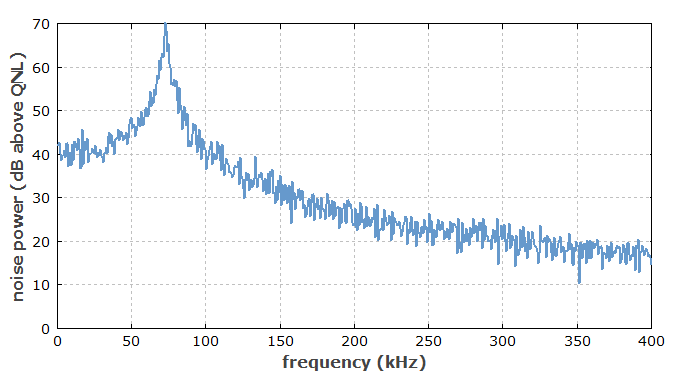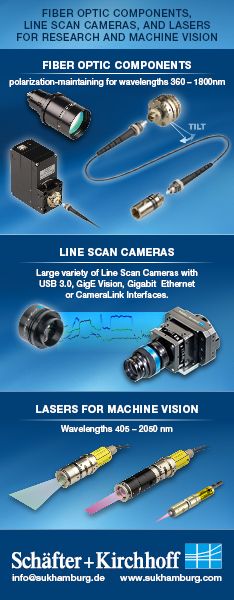Power Spectral Density
Acronym: PSD
Definition: optical power or noise power per unit frequency interval
German: spektrale Leistungsdichte
Categories: fluctuations and noise, optical metrology
How to cite the article; suggest additional literature
Author: Dr. Rüdiger Paschotta
In optical technology and photonics, power spectral densities (also sometimes just called power densities) occur basically in two different forms:
- optical power spectral densities, defined as the optical power per optical frequency (or wavelength) interval, e.g. specified in mW/THz or mW/nm
- noise power densities, defined as the power spectral density of the fluctuations of a quantity such as an optical power or phase, where the frequency argument refers to a noise frequency (rather than to an optical frequency)
In the following, both types of quantities are discussed.
Optical Spectral Quantities
When the spectral distribution of optical power e.g. of some laser source or other light source is measured e.g. with an optical spectrum analyzer (e.g. a spectrograph), the result is usually given as some spectral quantities. For example, one may specify the radiant flux per unit optical frequency or wavelength, which is called the spectral flux. In other cases, one specifies a spectral intensity (radiant intensity per unit optical frequency or wavelength), or some other spectral quantities. The mentioned quantities are all quantities from the field of radiometry; similar spectral quantities are also used in photometry.
Radiant spectral quantities can in principle also be interpreted as power spectral densities. In some cases, they are mathematically calculated as the power spectral density of some kind of amplitude, e.g. involving statistical models. In many other cases, they are calculated from a total optical power in conjunction with a known spectral shape, or directly measured e.g. with some kind of optical spectrometer.
Optical power spectral densities are also required for visualizing e.g. pulse shapes with spectrograms. In that case, power spectral densities are calculated for limited time intervals by applying Fourier transforms to sections of data as extracted using some window function.
Noise Power Spectral Densities
In the case of noise powers, a PSD always refers to averaged power levels related to intervals of noise frequency (rather than optical frequency). Such noise PSDs can occur in the context of any optical or electrical signals. They can be used not only in conjunction with optical power (→ intensity noise), but also e.g. for phase noise, frequency noise, noise of a pulse duration, pulse energy, or timing jitter, e.g. of a mode-locked laser Similarly, PSDs can apply to electrical voltages or currents.

PSDs can be defined via the squared modulus of the Fourier transform of the quantity of interest, but the straightforward approach works only for functions which have significantly non-zero values only in a finite time interval. For the frequently encountered case of fluctuations around a long-term mean value (e.g., concerning the power or phase fluctuations of a continuous-wave laser), a definition such as

may be used for the (two-sided) PSD of a variable X(t). Here, the integral is restricted to a finite time interval (thus obtaining convergence of the integral), and the mean squared modulus of the Fourier transform is divided by the length T of the time interval. Finally, the limit for large time intervals T is calculated. This definition is conceptually clear, but not always convenient (in particular not for analytical calculations). Therefore, it is common to use the Wiener–Khinchin theorem (or Wiener–Khintchin theorem), which states that

where
is the autocorrelation function of X(t).
In any case, it is important to note that power spectral densities are statistical measures, which can be estimated from real data by averaging over the results from many measurements. Taking a single measurement trace gives only a very rough estimate of the PSD.
Power spectral densities can be specified as one-sided functions of only positive frequencies, or as (two times smaller) two-sided functions of positive and negative frequencies. Optical power densities are usually one-sided and can be measured e.g. with an optical spectrum analyzer. Noise PSDs are mostly one-sided in the engineering disciplines, but often two-sided in physics. Noise power densities can be measured with electronic spectrum analyzers or calculated from data recorded in the time domain. They are specified e.g. in dBc/Hz (dB relative to the carrier in a 1-Hz bandwidth) for the relative intensity noise, or in rad2/Hz for phase noise. Sometimes, square roots of such power densities are specified, with the peculiar units of e.g. rad per square root of a hertz.
The variance of a quantity (e.g. the optical phase) in a certain range of noise frequencies is given as an integral over the (one-sided) PSD:

The square root of such a value is a root-mean-squared (r.m.s.) value. Note, however, that such integrals do not always converge (e.g. when the PSD has a singularity at f = 0). In the case of phase noise, such a divergence is related to a finite linewidth. Noise integrals are also often used for calculating a signal-to-noise ratio.
Unfortunately, the measurement or calculation of power spectral densities is prone to many errors. Some frequent mistakes are:
- confusing one-sided and two-sided PSDs, or not making clear which ones are used
- inappropriate settings of electronic spectrum analyzers, e.g. concerning detector mode and averaging method
- the failure to apply certain correction factors (e.g. for the effective noise bandwidth) to data obtained with electronic spectrum analyzers
- the failure to remove artifacts by proper windowing, when PSDs are calculated from time-domain data
Adequate training concerning mathematical foundations, physical effects, and details of electronic spectrum analysis is required for dealing correctly with power spectral densities in laboratory environments.
Questions and Comments from Users
Here you can submit questions and comments. As far as they get accepted by the author, they will appear above this paragraph together with the author’s answer. The author will decide on acceptance based on certain criteria. Essentially, the issue must be of sufficiently broad interest.
Please do not enter personal data here; we would otherwise delete it soon. (See also our privacy declaration.) If you wish to receive personal feedback or consultancy from the author, please contact him e.g. via e-mail.
By submitting the information, you give your consent to the potential publication of your inputs on our website according to our rules. (If you later retract your consent, we will delete those inputs.) As your inputs are first reviewed by the author, they may be published with some delay.
See also: optical spectrum, spectral quantities, noise specifications, intensity noise, phase noise, laser noise
and other articles in the categories fluctuations and noise, optical metrology

This encyclopedia is authored by Dr. Rüdiger Paschotta, the founder and executive of RP Photonics Consulting GmbH. How about a tailored training course from this distinguished expert at your location? Contact RP Photonics to find out how his technical consulting services (e.g. product designs, problem solving, independent evaluations, training) and software could become very valuable for your business!
 |




If you like this page, please share the link with your friends and colleagues, e.g. via social media:
These sharing buttons are implemented in a privacy-friendly way!